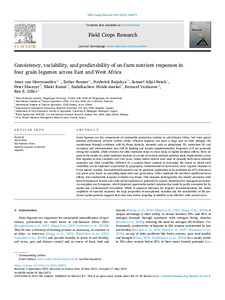| dc.contributor.author | van Heerwaarden, J. |
| dc.contributor.author | Ronner, E. |
| dc.contributor.author | Baijukya, F. |
| dc.contributor.author | Adjei-Nsiah, S. |
| dc.contributor.author | Ebanyat, P. |
| dc.contributor.author | Kamai, N. |
| dc.contributor.author | Wolde-Meskel, E. |
| dc.contributor.author | Vanlauwe, B. |
| dc.contributor.author | Giller, K. |
| dc.date.accessioned | 2023-06-06T09:55:28Z |
| dc.date.available | 2023-06-06T09:55:28Z |
| dc.date.issued | 2023-08 |
| dc.identifier.citation | van Heerwaarden, J., Ronner, E., Baijukya, F., Adjei-Nsiah, S., Ebanyat, P., Kamai, N., ... & Giller, K. (2023). Consistency, variability, and predictability of on-farm nutrient responses in four grain legumes across east and west Africa. Field Crops Research, 299:108975, 1-11. |
| dc.identifier.issn | 0378-4290 |
| dc.identifier.uri | https://hdl.handle.net/20.500.12478/8199 |
| dc.description.abstract | Grain legumes are key components of sustainable production systems in sub-Saharan Africa, but wide-spread nutrient deficiencies severely restrict yields. Whereas legumes can meet a large part of their nitrogen (N) requirement through symbiosis with N2-fixing bacteria, elements such as phosphorus (P), potassium (K) and secondary and micronutrients may still be limiting and require supplementation. Responses to P are generally strong but variable, while evidence for other nutrients tends to show weak or highly localised effects. Here we present the results of a joint statistical analysis of a series of on-farm nutrient addition trials, implemented across four legumes in four countries over two years. Linear mixed models were used to quantify both mean nutrient responses and their variability, followed by a random forest analysis to determine the extent to which such variability can be explained or predicted by geographic, environmental or farm survey data. Legume response to P was indeed variable, but consistently positive and we predicted application to be profitable for 67% of farms in any given year, based on prevailing input costs and grain prices. Other nutrients did not show significant mean effects, but considerable response variation was found. This response heterogeneity was mostly associated with local or temporary factors and could not be explained or predicted by spatial, biophysical or management factors. An exception was K response, which displayed appreciable spatial variation that could be partly accounted for by spatial and environmental covariables. While of apparent relevance for targeted recommendations, the minor amplitude of expected response, the large proportion of unexplained variation and the unreliability of the predicted spatial patterns suggests that such data-driven targeting is unlikely to be effective with current data. |
| dc.description.sponsorship | Bill & Melinda Gates Foundation |
| dc.format.extent | 1-11 |
| dc.language.iso | en |
| dc.subject | Soil Fertility |
| dc.subject | Sub-Saharan Africa |
| dc.subject | Nutrient Use Efficiency |
| dc.subject | Grain Legumes |
| dc.title | Consistency, variability, and predictability of on-farm nutrient responses in four grain legumes across east and west Africa |
| dc.type | Journal Article |
| cg.contributor.crp | Grain Legumes |
| cg.contributor.crp | Roots, Tubers and Bananas |
| cg.contributor.affiliation | Wageningen University and Research Centre |
| cg.contributor.affiliation | International Institute of Tropical Agriculture |
| cg.contributor.affiliation | Makerere University |
| cg.contributor.affiliation | University of Maiduguri |
| cg.contributor.affiliation | World Agroforestry |
| cg.coverage.region | Africa |
| cg.coverage.region | East Africa |
| cg.coverage.region | West Africa |
| cg.coverage.country | Ghana |
| cg.coverage.country | Nigeria |
| cg.coverage.country | Tanzania |
| cg.coverage.country | Uganda |
| cg.coverage.hub | Eastern Africa Hub |
| cg.coverage.hub | Headquarters and Western Africa Hub |
| cg.researchtheme | Natural Resource Management |
| cg.identifier.bibtexciteid | TIZE:2023b |
| cg.isijournal | ISI Journal |
| cg.authorship.types | CGIAR and developing country institute |
| cg.iitasubject | Agronomy |
| cg.iitasubject | Food Security |
| cg.iitasubject | Grain Legumes |
| cg.iitasubject | Plant Breeding |
| cg.iitasubject | Plant Production |
| cg.iitasubject | Soil Fertility |
| cg.journal | Field Crops Research |
| cg.notes | Open Access Article; Published online: 26 May 2023 |
| cg.accessibilitystatus | Open Access |
| cg.reviewstatus | Peer Review |
| cg.usagerightslicense | Creative Commons Attribution 4.0 (CC BY 0.0) |
| cg.targetaudience | Scientists |
| cg.identifier.doi | https://doi.org/10.1016/j.fcr.2023.108975 |
| cg.iitaauthor.identifier | Frederick Baijukya: 0000-0003-2586-2013 |
| cg.iitaauthor.identifier | Samuel Adjei-Nsiah: 0000-0002-7394-4913 |
| cg.iitaauthor.identifier | bernard vanlauwe: 0000-0001-6016-6027 |
| cg.futureupdate.required | No |
| cg.identifier.issue | 108975 |
| cg.identifier.volume | 299 |

